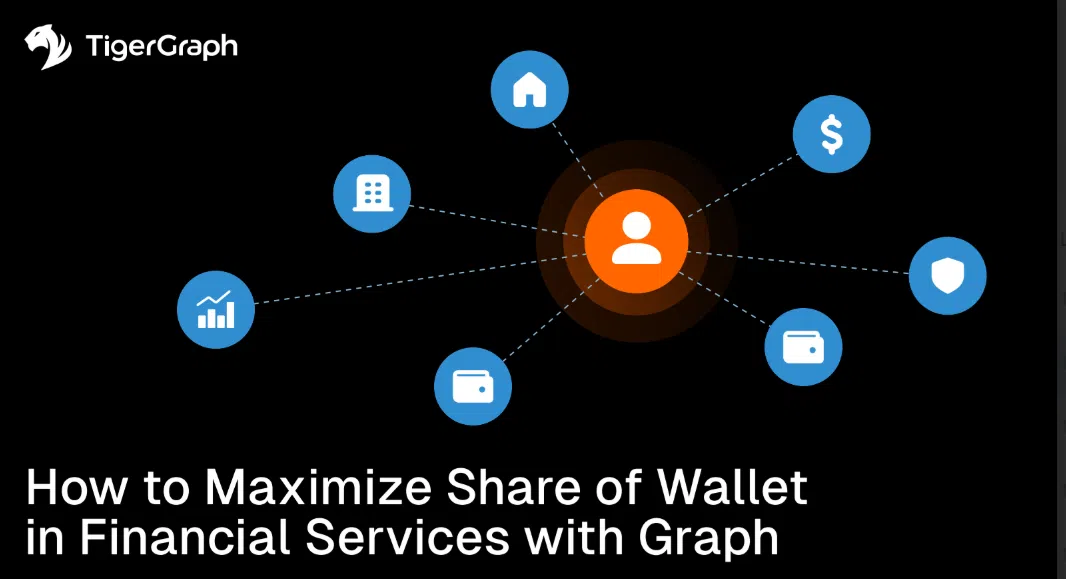Graph-Powered C360 Maximizes Share of Wallet in Financial Services
If you can’t see the full picture, you can’t build the full relationship. Today’s customers don’t think in terms of product lines. They’re thinking of life goals, like buying a home, saving for a child’s education, preparing for retirement, and protecting their family’s future. But most financial institutions still see them through a fragmented lens.
There’s a mortgage in one system, insurance in another, and then investments and checking accounts are each managed separately, too, and sometimes even by entirely different business units. This fragmentation is obviously a data management issue, but it’s also a barrier to growth.
Customers don’t split their financial lives across institutions because they prefer complexity, but because no one has earned their full trust through a connected, consistent experience.
Customer 360 (C360) offers a way forward.
What is C360?
At its core, Customer 360 is about seeing the customer as a whole person, not just a collection of accounts. It’s a strategy that connects data across products, departments, and interactions to create a unified, real-time view of each customer’s financial life.
Instead of tracking isolated transactions, C360 helps banks, credit unions, and insurers understand customers’ life stages, goals, and relationships. This bigger picture allows institutions to engage more personally, anticipate needs, and build stronger, long-term relationships.
And this is where graph makes all the difference.
Unlike traditional databases that store customer information in disconnected tables, graph technology naturally models the relationships between people, products, events, and behaviors. It mirrors how real financial lives work—interconnected, evolving, and context-driven. Graph doesn’t just collect data; it shows how everything connects. That makes it the ideal foundation for Customer 360.
With graph, C360 becomes more than a dashboard. It becomes a living, connected map of each customer’s financial world, allowing institutions to personalize service, predict needs, and deepen trust.
It shifts the focus from product-centric tracking to relationship-centered understanding. It empowers banks, credit unions, and insurers to deliver the relevance and personalization that drives deeper engagement and, ultimately, greater wallet share.
The Growth Barrier: Siloed Accounts, Shallow Understanding
For most financial institutions, customer data is siloed by design. Each department owns its slice of the relationship. The checking account team, lending team, and retirement planning group pass by like ships in the night through your CRM systems, which may or may not be connected. And the records from each business unit might note when a product was sold, but they rarely explain why the customer bought it or what they might need next.
Worse still, these systems rarely talk to each other. Which means you can’t:
- Recognize when a customer’s growing family signals a need for life insurance.
- Detect that a long-time client’s business is expanding and now requires commercial lending.
- See that a customer is preparing for retirement, because their investment behavior lives in a separate platform from their checking account or home equity line.
This results in missed timing, generic offers, and slowed growth.
To maximize share of wallet, institutions must evolve from treating customers as a series of disconnected transactions to understanding them as complex, evolving entities. They need to see people’s needs, influences, and intentions as they change over time. Doing so requires data, and it also requires context.
And this is where graph technology changes the equation.
Why Graph Technology Changes the Equation
Graph technology is uniquely suited to address these challenges because it doesn’t just store data; it models relationships. Instead of flattening customers into rows on a spreadsheet, graph databases create and manage networks of people, accounts, products, and behaviors, connected in ways that mimic real life.
This native relationship modeling allows you to:
- Uncover hidden connections, such as a client whose investment activity is indirectly tied to a spouse’s education savings account.
- Detect shared intent across members of a household or business, like a family simultaneously adjusting contributions to a 401(k) and opening a 529 plan.
- Spot financial transitions as they happen, including retirement readiness, college planning, new home purchases—and time your outreach accordingly.
Where traditional systems offer a static snapshot, graph offers a living map that is continuously updating as customer behaviors evolve.
What TigerGraph Adds to the Mix
TigerGraph takes this further by enabling these insights at scale:
- Real-time traversal across billions of nodes and edges,
- Schema-first design that aligns with regulatory and business models,
- Multi-hop relationship detection that uncovers risk or opportunity chains that other systems can’t see.
This means you’re not guessing at the next best action. Instead, you’re modeling it dynamically, based on what’s actually happening in your customer’s financial life.
While graph technology provides the foundation for uncovering hidden connections, TigerGraph delivers the scale, speed, and usability needed to operationalize Customer 360 in complex financial ecosystems.
Banks and insurers need real-time, auditable intelligence that can be embedded into everyday decision-making. This is where TigerGraph excels.
With TigerGraph, financial institutions can:
- Unify fragmented data across accounts, systems, and lines of business using advanced entity resolution. Even when names, addresses, or account numbers don’t align perfectly, TigerGraph helps create a single, accurate view of the customer, whether they’re an individual, a family, or a business.
- Model complete household and business relationships, uncovering shared financial goals, cross-product dependencies, and risk exposure across networks of related entities. This approach extends beyond traditional householding by integrating behavioral, intent, and engagement signals into the model.
- Detect life transitions and financial signals in real time. Did a customer just make a large transfer, change their contribution rate, or open a new joint account? TigerGraph surfaces these shifts as they occur, so teams can proactively engage with the right message at the right moment.
- Enable context-aware recommendations that go beyond simplistic rule-based offers. Instead of recommending a credit card because the customer clicked a link, TigerGraph enables systems to recommend a financial plan because it understands the customer’s network, history, and life stage.
- Deliver explainability and trust in all of the above. With a schema-first, query-transparent approach, TigerGraph aligns with compliance and audit needs while supporting dynamic personalization and customer care.
It also supports regulatory initiatives such as KYC, AML, and ESG reporting by modeling complex relationships, tracking behavior shifts, and maintaining full audit traceability across changing data environments
Real-World Scenario: Connecting the Dots Before the Competition Does
Let’s say a bank has two customers that are seemingly unrelated at the account level. One recently increased their 401(k) contributions. The other just opened a 529 savings plan. Nothing remarkable—until graph reveals they’re spouses.
Now take that a step further: Their joint account shows increased deposits, and there’s a new home address tied to a recent mortgage approval. Graph surfaces a life transition in progress, which is likely the birth of a child or early-stage college planning.
Instead of sending both customers generic offers for personal loans or credit cards, TigerGraph enables the institution to recommend a tailored long-term portfolio strategy consultation, introduce diversified investment products, or schedule a retention call with a relationship manager. And this can all happen before the customer has to ask.
This is the power of graph-based Customer 360. It helps financial services understand people not just as account holders, but as families, networks, and decision-makers with changing needs.
Don’t Just Serve a Product—Build a Relationship
Financial loyalty is earned, and seeing your customers clearly is your competitive edge. That means more you need to go beyond managing accounts to understanding lives in motion.
Graph technology gives you this context, and TigerGraph gives you the capability.
By mapping relationships, tracking transitions, and revealing the invisible signals that precede opportunity, TigerGraph helps financial institutions move from transactional thinking to relationship intelligence. It’s the next evolution in financial services, where institutions stop reacting to customer activity and start anticipating customer need.
If your goal is to become the one institution your customer turns to for every milestone and decision, then it’s time to stop working in silos and start seeing the whole picture. Start with graph. TigerGraph gives you the precision, scale, and speed to build real-time relationship intelligence—and we can help you map a clear, compliant path from insight to impact.
Try TigerGraph Cloud free at https://tgcloud.io and explore how real-time relationship intelligence can power smarter retention, expansion, and growth.

